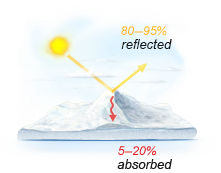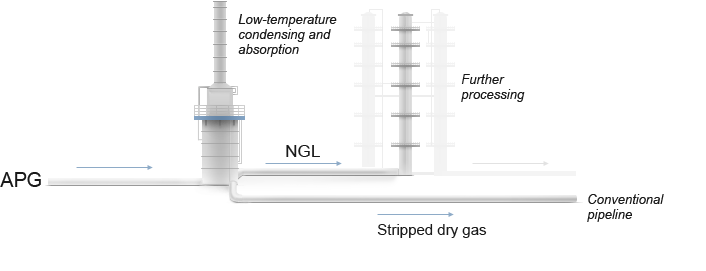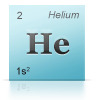Associated petroleum gas (APG) is gas dissolved in oil. Associated petroleum gas is produced in the process of oil production, so it is actually a derivative. But APG itself is also a valuable raw material for further processing.
Molecular composition
Associated petroleum gas is composed of light hydrocarbons. First of all, from methane, which is a major component of natural gas, and from other heavier components, such as ethane, propane, butane and others.
All these components differ in the number of carbon atoms in a molecule. Thus, there is one carbon atom in a methane molecule, two in ethane, three in propane, four in butane, etc.

~ 400,000 tons is the carrying capacity of an oil supertanker.
According to the World Wildlife Fund (WWF) data, in oil producing regions the annual volume of solid pollutants emitted into the atmosphere (APG combustion products accounting for their considerable part) reaches 400,000 tons.
Ecologists’ fears
Associated petroleum gas should be separated from oil for the oil to comply with the applicable standards. For a long time, APG used to be a by-product for oil companies, that’s why the problem of its disposal was settled in rather an easy way – it was burnt.
Not too long ago when flying over Western Siberia one could observe a multitude of burning flares: that was associated petroleum gas being burnt.
In Russia the annual emission volume of CO2 caused by gas combustion in flares totals some 100 million tons.
Another threat lies in black emissions: ecologists think that black microparticles may travel long distances and settle on snow or ice surface.

Even the slightest pollution of snow and ice unseen for the eye, considerably decreases their albedo, that is their reflectivity. As a result, snow and surface air heat up, and our planet reflects smaller amounts of solar radiation.
Reflectivity of unpolluted snow:

Changes for better
Recently, the situation with APG disposal has started to change. Oil companies pay more and more attention to the issue of associated gas rational use. This process is accelerated by the Russian Federation Government Resolution No.7 of January 8, 2009, which stipulates the requirement that the associated gas use level should reach 95 per cent. If this doesn’t happen, oil companies will be liable to stiff fines.
Gazprom elaborated the Medium-Term Investment Program for Enhancement of APG Use Efficiency over 2011 to 2013. In 2010 the APG use level within Gazprom Group amounted to the average of 64 per cent, moreover, Gazprom Dobycha Orenburg, Gazprom Pererabotka and Gazprom Neft Orenburg already use 100 per cent of APG.
Options of use
There are many ways of APG rational use, but only few are applied in practice.
The basic way of APG use is its separation into components, mostly represented by stripped dry gas (actually, natural gas, methane for the most part, which may contain some ethane). The second group of components is represented by natural gas liquids (NGL). It is a substance mixture with two or more carbon atoms (C2+ fraction). It is this mixture which is used as a raw material in petrochemistry.

Associated petroleum gas separation processes run at low-temperature condensing and low-temperature absorption units. After the separation, stripped dry gas may be conveyed through a conventional pipeline, whereas NGL may be delivered for further processing to produce petrochemicals.
According to the data provided by the Ministry of Natural Resources and Environment, in 2010 largest oil companies used 74.5 per cent and flared 23.4 per cent of the total amount of gas produced.
The plants for gas, oil and gas condensate processing into petrochemicals are high-technology complexes combining chemical and petrochemical facilities. Hydrocarbon feedstock is processed at facilities of Gazprom’s subsidiaries, that is at the Astrakhan, Orenburg and Sosnogorsk Gas Processing Plants, the Orenburg Helium Plant, the Surgut Condensate Stabilization Plant and the Urengoy Condensate Treatment Plant.
Associated petroleum gas may also be used at power generation units for – this allows oil companies to settle the issue of power supply to infrastructure facilities without electricity purchases.
Moreover, APG may be reinjected into a formation to increase the oil recovery factor. This process is called cycling.



